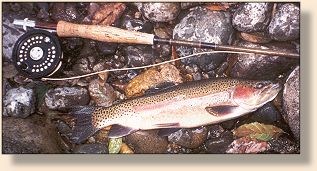Snowbird Destinations - Tico Trout

By Rory E. Glennie
I ventured Southwest from San Jose, Coasta Rica, for about
an hour-and-a-half along the badly potholed Inter-American
highway, high into the Sierra de la Muerte - the "Mountains
of Death." Adjoining the border with Panama, these promontories
are named by the locals for the long history of mysterious
deaths and disappearances of people venturing into the jungles
there. Here, amongst the specters of lost souls in the mist
forest at twelve thousand feet above sea level, but only nine
degrees north of the equator; there are some great little trout
streams.
Diaspora
In the twilight of the Empire, homesick British fly fishers
took brown trout and roses with them around the globe, from
Australia to Africa, where, in some cases, the trout thrived
and developed into world class fisheries. That Canadians
exported native trout is less well-known, but it happened.
Back in the thirties, Donaldson strain of Kamloops rainbows
were shipped out for stocking in a variety of places. One of
these was Costa Rica. Some years later they were augmented with
a batch of McLeod River strain shasta rainbows from America.
Today, there are naturalised Donaldsons, MacLeods, and hybrids
of the two thriving in Costa Rica. "Tico trout," an affectionate
nickname Costa Ricans call themselves, would not be an inappropriate
name for these expatriates, especially the hybrids.
A Lot Like Home
Trout are not what one would normally associate with going
fly-fishing in the tropics, but they thrive in some of the
high elevation rain-forest streams of southern Costa Rica.
One of these, the Rio Sevegre, drains the Mountains of Death
westward, eventually dumping into the Pacific Ocean sixty or
so miles away. This stream is steeply graded, bouldery, and
spring-fed (reminiscent of Roderick Haig-Brown's favorite
summer steelhead stream, the Heber River on Vancouver Island)
in October before any fall rains freshen the flow. At this
elevation, the Rio Sevegre is a seemingly endless, stair-step
series of miniature cascades and waterfalls tumbling into tiny
pools. As it is spring fed, the water temperature remains
fairly constant, hovering somewhere between 15 adn 20 degrees Celsius
year-round. Since it is slightly on the alkaline side, the
water grows bugs and the trout that feed on them well.
 The trout I managed to hook on that trip averaged about eleven
inches long, with the smallest about six inches and the largest
measuring in at a respectable eighteen inches. Even the small
fish were strong fighters for their size, and the largest one
fought very well indeed. That great fish eventually came to
hand dangling a ten-inch length of monofiliment from its mouth.
Closer inspection showed a fly fastened well down in the throat
area. Apparently, this trout had broken off someone in the
past and lived to fight another day. I snipped the mono and
gently returned the fish to the stream trailing a shortened
tippet.
The trout I managed to hook on that trip averaged about eleven
inches long, with the smallest about six inches and the largest
measuring in at a respectable eighteen inches. Even the small
fish were strong fighters for their size, and the largest one
fought very well indeed. That great fish eventually came to
hand dangling a ten-inch length of monofiliment from its mouth.
Closer inspection showed a fly fastened well down in the throat
area. Apparently, this trout had broken off someone in the
past and lived to fight another day. I snipped the mono and
gently returned the fish to the stream trailing a shortened
tippet.
 Almost all the fish were healthy, good looking, colorful specimens
of Shasta rainbows - tiny heads with ruby-tinted gill plates,
plump bodies sporting a few black spots (mostly above the
lateral stripe overlaying a buttery yellow skin. The Canadian
Donaldson were more elusive. But there was one fish, more
silvery than the others, which I swear winked at me - finally,
I had encountered a fellow expatriate from Kamloops.
Almost all the fish were healthy, good looking, colorful specimens
of Shasta rainbows - tiny heads with ruby-tinted gill plates,
plump bodies sporting a few black spots (mostly above the
lateral stripe overlaying a buttery yellow skin. The Canadian
Donaldson were more elusive. But there was one fish, more
silvery than the others, which I swear winked at me - finally,
I had encountered a fellow expatriate from Kamloops.
While I encountered only the one Kamloops trout on that stream,
I did meet up with others before I actually began fishing. A
teaser to my expectations, these were prime specimens averaging
seven pounds, held in a spring-fed pond. They were gorgeous,
perfectly formed, and silver-sided. But they were off-limits,
as they were kept as brood fish for the stocking program.

Since fishing on the Rio Sevegre is regulated as a catch-and-kill
trout fishery, the stream-bred fish are harvested regularly and
need some assistance in replacement. Operated in conjunction with
the restocking hatchery is an enterprise where, for a fee based on
the per pound weight of the fish kept, a person can fish an
adjoining well-stocked spring fed pond. Folks can hoist out
twelve to twenty inch trout until their arms ache, or their bank
account gives out. The pond fisher's bounty is quickly killed,
weighed, cleaned and bagged by the hatchery operator immediate
after it is caught.
This takes a lot of pressure off the stream dwelling trout,
and encourages catch and release trout fishing for fun. The
money taken in from the pay-to-play fishpond subsidizes the
cost of raising trout for stream stocking.
~ Rory E. Glennie
Continued next time!
We thank the
Canadian Fly Fisher for re-print permission!
Our Man In Canada Archives
|







